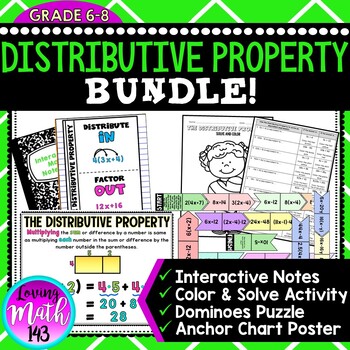The Distributive Property Poster, Notes, and 2 Activities Bundle
- Zip
- Easel Activity
What educators are saying
Products in this Bundle (5)
Description
THE DISTRIBUTIVE PROPERTY: POSTER, NOTES, AND 2 ACTIVITIES BUNDLE
***********************************************************************************************
1. The Distributive Property - Anchor Chart Poster
This anchor chart poster is a visual representation of the distributive property. It provides conceptual understanding of multiplying the sum or difference by a number is the same as multiplying each number in the sum or difference by the number outside the parentheses. Students will be able to use an area model to make sense of the distributive property.
This poster makes for great classroom poster, anchor chart, reference sheet classroom scaffold/tool.
***********************************************************************************************
2. The Distributive Property: Distribute IN & Factor Out Guided Notes
This foldable is guided notes for the applying the distributive property for algebraic expressions. Students will clearly see how to distribute IN to the parentheses to create an equivalent expression and factor out the greatest common factor to create an equivalent expression.
These interactive notes include an example distributing in and factoring out. Students will see that to distribute in we must multiply and to factor out we must divide.
These guided notes will make an excellent addition to your students' interactive math notebook and/or binder! FOUR inside versions are included! This is aligned with the 6th and 7th grade common core standards.
***********************************************************************************************
3. Equivalent Expressions using the Distributive Property - Dominoes Math Activity
This fun and engaging activity is a great way to check for understanding of the Distributive Property. Students will create equivalent expressions using the Distributive Property to find the next puzzle piece. Each puzzle piece connects like Dominoes. Students will Distribute into the parentheses to create 15 equivalent expressions. This activity is aligned with the 6th grade Common Core Standards.
This activity works great in small groups, stations, math centers, or self-assessing. Students will be asking for more activities like this!
***********************************************************************************************
4. Equivalent Expressions Distributive Property - Color and Solve Math Activity
This color and solve activity is a fun and engaging way for students to practice distributing in to parentheses to create equivalent expressions and factoring out the greatest common factor. Students must distribute in to create an equivalent expression and factor out using the greatest common factor (GCF) to create the equivalent expression. This solve and color activity is perfect for Valentines Day, or any time throughout the school year! This activity is aligned with the sixth (6th) grade common core standards.
***********************************************************************************************
LICENSING TERMS: This purchase includes a license for one teacher only for personal use in their classroom. Licenses are non-transferable, meaning they can not be passed from one teacher to another. No part of this resource is to be shared with colleagues or used by an entire grade level, school, or district without purchasing the proper number of licenses.
COPYRIGHT TERMS: This resource may not be uploaded to the internet in any form, including classroom/personal websites or network drives, unless the site is password protected and can only be accessed by students.


